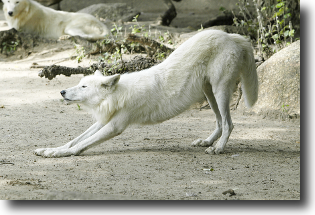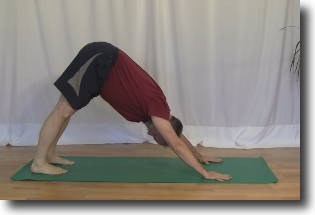It is a sunny day and Old Yeller just woke up. He lifts his hips to the sky and lowers his head towards the ground. There is a big grin on his face as he stretches the muscles in his back and legs. After a few breaths he lifts up and with a wag of his tail walks over to his bowl for a drink of water.
Old Yeller does a down dog quite naturally, but we need all the help we can get to do it safely.
There are two parts to the foundation of Downward Facing Dog. Your hands and your feet. Getting your hands in the right place is covered in another article. In this article we are focusing on getting the rest of the foundation, your feet, taken care of.
What is Downward Facing Dog
Downward Facing Dog is a mild forward fold. You do look just like Old Yeller when you are in this pose. Both you and the dog look like a pyramid when you are in this pose. You have your hands and feet on your mat with your hips lifted up to the ceiling.
In Sanskrit Downward Facing Dog is know as “Adho Mukha Svanasana” which is pronounced like this “AH-doh MOO-kah shvah-NAHS-Anna” The parts of the Sanskrit are adho which means downward, mukha is your face and svana is dog. The literal translation of the Sanskrit name Adho Mukha Svanasana is Downward Facing Dog.
Downward Facing Dog is one of the poses that make up Sun Salute A and B. It occurs once in Sun Salute A and three times in Sun Salute B. Downward facing dog is held for five breaths in Sun Salute A. The first two in Sun Salute B are held for an exhale only before you move on to the next pose in the series. The last one in Sun Salute B is held for 5 breaths in the same way as it is in Sun Salute A.
You do a lot of Downward Facing Dogs when you do a series of Sun Salutes. In addition to it being a great stretch, there are a many benefits to doing all of those Downward Facing Dogs.
Why do Downward Facing Dog
This pose helps to calm your mind, relieve stress and mild depression. It also energizes your body while it helps with high blood pressure, asthma, sinusitis, flat feet and sciatica.
Downward Facing Dog stretches your hands, shoulders, hamstrings, calves and the arches of your feet. It is a load bearing pose and as a result it helps to prevent osteoporosis.
Since you spend a lot of time in this pose it is important get the foundation setup correctly. Let’s have a look in detail at how to do a Sun Salute and then we will look specifically at your feet.
How to do Downward Facing Dog
You enter this position of the Sun Salute series from Upward Facing Dog. While it has a similar name, Upward Facing Dog, is a very different pose. You can find out more about it at the end of this article.
From Upward Facing Dog you:
— Start exhaling as you push into your hands and lift your hips up towards the ceiling and backwards towards your feet.
— Your legs remain straight as you lower your heels towards the floor.
— While you take your hips up and back towards your feet you bring your shoulders back towards your feet so that you have a straight line from your hips through your shoulders to your hands.
— Tuck your chin in towards your chest and bring your gaze to your navel as you engage Uddiyana Bandha.
— Walk your feet towards your hands about the length of one of your feet.
You may find that you do not have enough upper body strength to move into the pose as described above.
What to do if you lack upper body strength
There is an other way to get into Downward Facing Dog that works with the amount of strength that you have.
From Upward Facing Dog you:
— Start exhaling as you lower your knees to the floor and bring your hips towards your heels. This is similar to Child’s pose or Balasana.
— Now pushing into your hands lift your knees up and take your hips up toward the ceiling straightening your legs and bringing your heels down towards the mat.
— Finally bring your shoulders back towards your feet and create a straight line from your hips through your shoulders to your hands.
— Tuck your chin in towards your chest and bring your gaze to your navel as you engage Uddiyana Bandha.
— Walk your feet towards your hands about the length of one of your feet.
Regardless of how you got into the pose you hold here for either one exhale or for five full breaths before you move on to the next pose in the Sun Salute Series.
There is a lot of weight in your hands and feet while you are in the pose. There are few things that can go wrong in this pose if you do not get your feet in the right place.
What can go wrong with your feet
To properly support your weight you need your feet in the correct place on your mat. Your feet can be too close together or they could be too far apart. Not only that, your feet can be turned inward or outward. All of these placements will put unbalanced stress and strain on your hip and ankle joints.
The good news is that it is fairly easy to get your feet in the right place.
How to get your feet in the right place
While you are in Downward Facing Dog you can see your feet and it is easy to see if you have good alignment and correct it.
First of all you get the correct distance between your two feet. The space normally is about the width of your two feet between your feet which is about 6 to 8 inches.
To accomplish this, first bring your feet side by side with your big toes touching. Now move your feet apart by putting your big toe where your baby toe is. Your feet are now in line with your hips and your legs are coming straight down to the mat from your hips to your ankles.
Now that your feet are the correct distance apart you need to get them pointing in the correct direction.
Your heels should be slightly wider than your toes. Check your feet and move your heels inwards or outwards until the heel is slightly wider than your toes.
To finish this off, bring your heels towards the floor and lift your arches and toes up off of the floor. This slight movement will cause all of the muscles in your leg to engage and support you in the pose.
But my heels won’t come to the mat
This happens a lot when you first start doing Downward Facing Dog. Everyone starts out with short hamstrings and their heels are stuck up in the air.
If your hamstrings are really short not only will your heels be in the air but you will not be able to straighten your legs either. This is fine. Listen to the feedback from your body and follow your edge and only go into the pose as far as you are comfortable. Keep your knees bent and gradually lower your heels towards the floor until you need to stop. Holding here in this position is much better than forcing your heels to the floor and injuring your hamstrings.
You can also bring your feet closer to your hands. This will help to get your heels closer to the floor.
It is very important to work with your yoga teacher to get the correct action happening that will help to get your heels to the floor safely.
Summary
Your feet are the second half of the foundation in this pose. It is important to get your feet in the correct place on your mat relative to your hips to avoid injury and get the maximum benefit.
Old Yeller naturally got his feet in the right place when he did his stretch. We are not so lucky and we can use all of the help we can get.
Next Step
Ask your yoga teacher to check out your feet in Downward Facing Dog. Between the two of you, you will get your feet in a safe place.
If you found this article useful have a look at my book Injury Free Yoga – The Sun Salute Series.
Additional Reading
To learn more about your hands in Downward Facing Dog you can read an article and watch a video:
— the video How to avoid injuring your wrists in downward facing dog
— the article How to avoid injuring your wrist in downward facing dog
To find out more about Upward Facing Dog, the pose you do just before Downward Facing Dog, have a look at these many articles on the blog.
Your Edge is an important concept that protects you from injuring yourself. You can find out more about it by readinghow Goldilocks and the Three Bears found the Edge.





